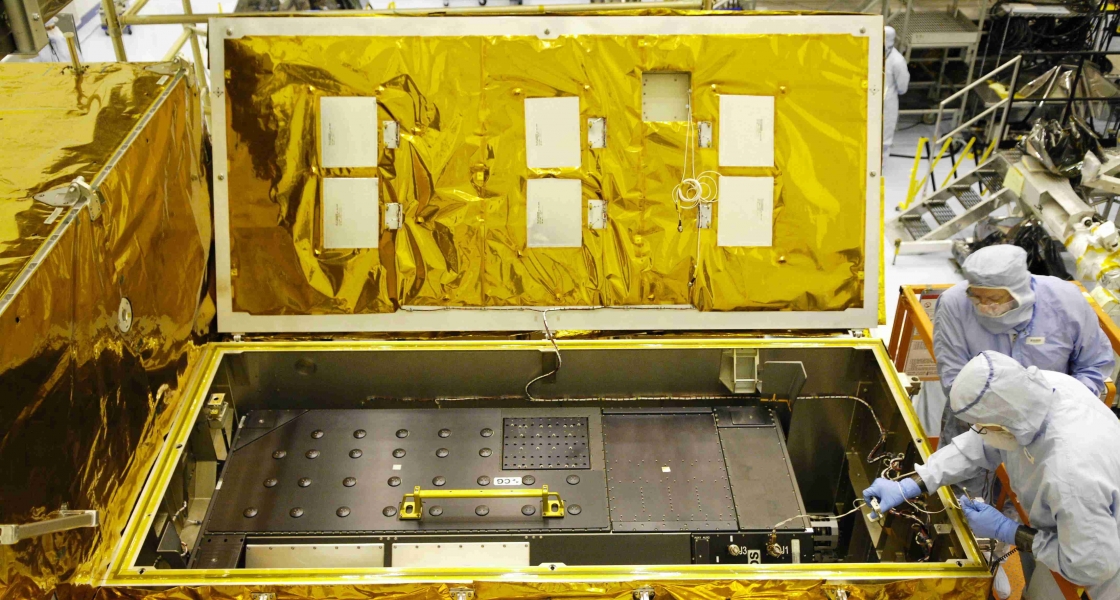The Cosmic Origins Spectrograph, or COS, is a powerful new instrument scanning the Universe. COS was installed on the Hubble Space Telescope in 2009. Since then, it has been searching for clues about the composition of the Universe, including how galaxies like our own Milky Way formed and evolved over time. It is seeing beautiful things never before detected in the Universe because it is the lowest-noise ultraviolet (UV) spectrograph ever built for space exploration.
The $70 million, telephone booth-sized instrument was designed at the University of Colorado at Boulder (UCB) and built by Ball Aerospace & Technologies Corp. of Boulder (Figure 1). JILA Fellow Jeff Linsky helped design the instrument and is a member of the COS science team. He is now reaping the benefits of the instrument’s ability to extract meaningful signals from what was just instrument noise on earlier space-borne UV spectrographs. With the help of collaborators including research associate Hao Yang, undergraduate student Rachel Bushinsky, and Kevin France of UCB’s Center for Astrophysics and Space Science, Linsky is now analyzing a wealth of COS data from young suns with protoplanetary disks of gas and dust in the process of forming planets.
In young binary star systems, for example, the researchers were able to identify evidence of molecular hydrogen (H2) being excited by radiation of their stars. H2 molecules are major constituents of protoplanetary disks, but they are virtually impossible to detect unless their electrons are being excited to higher electronic states or returning to lower electronic states by emitting ultraviolet light. Although other observatories have long detected the energetic UV fluorescence from H2 molecules, COS is the first instrument to find evidence of the stars themselves exciting, or “pumping,” the H2 molecules. The evidence consists of weak absorption lines seen against the bright atomic-hydrogen Lyman-alpha emission lines from the stars.
From the absorption in the pumping lines created by newly excited H2 molecules, the researchers were able to measure absorbed energy and compare it with the energy emitted by UV fluorescence. They discovered that energy was missing at certain wavelengths and concluded they were observing UV emission through the accretion flow from the disk onto the stars.
In a related study, Linsky, Yang, France, and colleagues from the United States and Europe found the first evidence of carbon monoxide (CO) in far UV spectra of the inner regions of protoplanetary disks of three stars. CO is one of the simplest molecular building blocks of planets. “This work represents the first steps in empirically determining the chemical composition of the protoplanetary disk where planets will form,” Linsky says. “Being able to measure the amount of both CO and H2 is important in determining the composition and evolution of planetary atmospheres.”
Linsky’s analysis of CO and H2 in the very young star systems indicates that protoplanetary disks are made of very primitive material. For example, the ratio of CO to H2 in the inner part of these disks is approximately 1. This value represents a transition between the much lower value found in the interstellar medium and the higher value found in solar system comets, which formed from a similar disk more than four billion years ago.
In a third COS study, Linsky, France, and colleagues from UCB analyzed UV emissions from solar-type stars, some younger than the Sun and some older. Their goal was to learn more about the far-UV emissions from the young Sun and how such emissions affected the young Earth’s atmospheric chemistry. The researchers focused on the COS instrument’s first-ever measurements of the far UV continuum emission produced by magnetically heated gas in the outer layers of the stellar atmospheres. Before COS, this faint continuum emission could not be detected between the stars' bright emission lines. The researchers found that the continuum emission from young, rapidly rotating stars was brighter (more intense) than that from older, more slowly rotating stars like the Sun. However, the continuum emission from the young stars was similar to what is seen in regions of the Sun with strong magnetic fields.
By using the Sun as a kind of “Rosetta Stone,” the scientists were able to deduce that the young Sun (like the young stars observed by COS) was once covered with very strong magnetic fields. Today, only weak remnants of these fields remain in the Sun and other older stars.
“Thanks to COS, my group is now doing stellar archaeology,” Linsky says. - Julie Phillips




